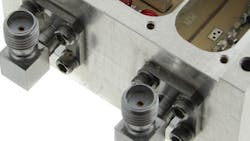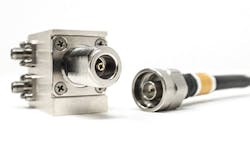When it comes to electronics, technology is moving forward at a rapid pace, with component manufacturers trying to keep up. Devices are becoming smaller and more complex, whether it is a smartphone, medical imaging device, or a remote sensor accessing military satellite systems. At the same time, the devices still need to be rugged enough to withstand enormous amounts of wear and tear while offering unhindered data transmission and collection capabilities.
The new requirements of electronic product manufacturing mean that connector components need to be redesigned for these devices (Fig. 1). The redesign is not always easy, as the connectors themselves must be micro-miniature and sub-miniature in nature. In addition, original equipment manufacturers (OEMs) need more customizable design options for their products for specific applications. Manufacturers are striving to meet these changing RF trend demands by offering flexible cables with reliable interfaces, trusted connections, and portability features.
1. This photo shows an example of a microwave connector used in various RF filter designs.
When Space and Performance Matters
To account for smaller electronic devices, RF trends are moving toward lower profile components. Devices still have complex assemblies, yet the size and weight requirements have been significantly lowered to allow for more portability features.
Based on the type of plug that is desired for the connector, many OEMs are searching for microwave assemblies that provide higher-speed interfaces up to 67 GHz that utilize 1.85-mm connectors capable of high mating cycles.
Higher-Frequency Demands for Greater Data Transmission
Device systems are now trending toward fiber-optic and microwave cables due to the tremendous amounts of data being transmitted and received. These complex systems are moving from traditional single-digit GHz performance levels to frequency requirements above 40 GHz.
RF connectors for microwave cables are now intended to provide a solution for smaller mechanical components that offer higher-packaging densities while still maintaining a superior performance level. Manufacturers are now focused on providing high-speed coaxial RF connectors to meet telecommunications technology demands, all the while keeping them compliant with the MIL-STD-348B standard RF dimensional requirements for military interfaces.
Variable Connection and Disconnection Capabilities
Military system applications sometimes require RF cables that can disconnect on command. Due to this requirement, connectors can experience problems when disconnecting at the wrong times or from pin-mating issues. Connector options need to be more flexible to meet these applications without affecting the higher-frequency and performance needs of the system.
Changing the number and position of pins can help to alleviate the issue of having a sure mating while allowing for the cable to disconnect when desired. However, operating systems have moved toward needing higher performance at frequencies of 28 GHz or more. Present keying schemes have only allowed for frequencies as high as 8 GHz.
Keyed coaxial connectors are being introduced for electronics that allow for 18-GHz performance while providing keyed position options. This setup minimizes mating issues while providing a more reliable connection to handle systems that experience high shock and vibration in varied environments.
Newer Design Capabilities to Reduce Compression
When looking at an old coaxial cable, the first thing to notice is the rigid design of the cable at the attached point of the connector. Terminated cables may experience compression when being twisted and turned, affecting the durability of the connector and causing a negative impact to connector performance.
This RF trend requires connector designs to be more flexible. Manufacturers are looking at connectors that supply sure mating with a failure-proof coupling nut while offering cable plugs that allow for different polarizations (Fig. 2).
2. Shown is a field-replaceable bulkhead RF filter mating with coupling nut.
As Technology Advances, More Customized Connector Solutions Are Required
The forward pace of technology is expected to go faster as our data transmission needs increase. Connectors need to be able to rise up to this challenge without lagging behind in either performance or operational options. RF connectors need to be designed in the correct configuration desired for the specific product or application, whether it will be used for satellite devices, mobile communication, or even in electronic warfare applications.



